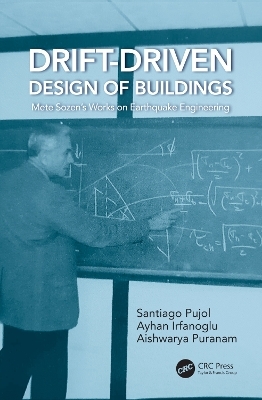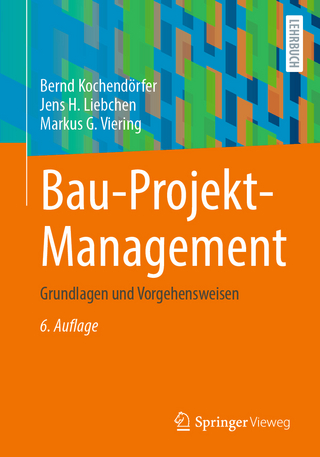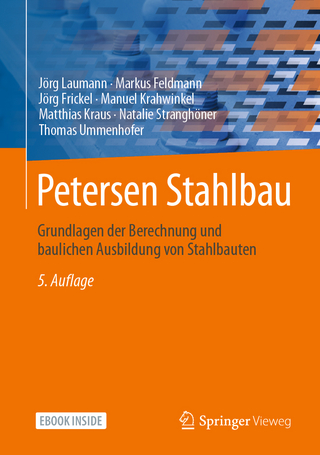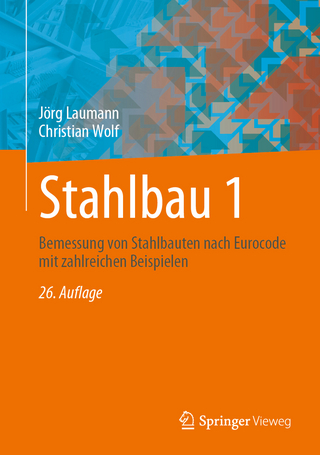
Drift-Driven Design of Buildings
CRC Press (Verlag)
978-1-032-25178-3 (ISBN)
This book summarizes the most essential concepts that every engineer designing a new building or evaluating an existing structure should consider in order to control the damage caused by drift (deformation) induced by earthquakes. It presents the work on earthquake engineering done by Dr. Mete Sozen and dozens of his collaborators and students over decades of experimentation, analysis, and reconnaissance. Many of the concepts produced through this work are integral part of earthquake engineering today. Nevertheless, the connection between the concepts in use today and the original sources is not always explained. Drift-Driven Design of Buildings summarizes Sozen's research, provides common language and notation from subject to subject, provides examples and supporting data, and adds historical context as well as class notes that were the result of Sozen’s dedication to teaching. It distills reinforced concrete building design to resist earthquake demands to its essence in a way that no other available book does. The recommendations provided are not only essential but also of the utmost simplicity which is not the result of uninformed neglect of relevant parameters but rather the result of careful consideration and selection of parameters to retain only those that are most critical.
Features:
Provides the reader with a clear understanding of the essential features that control the seismic response of RC buildings
Describes a simple (perhaps the simplest) seismic design method available
Includes the underlying hard data to support and explain the methods described
Presents decades of work by one of the most prolific and brilliant civil engineers in the United States in the second half of the 20th century
Drift-Driven Design of Buildings serves as a useful guide for civil and structural engineering students for self-study or in-class learning, as well as instructors and practicing engineers.
Santiago Pujol is Professor of Civil Engineering at the University of Canterbury. Prior to moving to New Zealand, he was Professor of Civil Engineering at the Lyles School of Civil Engineering, Purdue University. His experience includes earthquake engineering, evaluation and strengthening of existing structures, response of reinforced concrete to impulsive loads and earthquake demands, instrumentation and testing of structures, and failure investigations. He is a Fellow of the American Concrete Institute (ACI), and member of ACI committees 445 (Torsion and Shear), 314 (Simplified Design), 133 (Disaster Reconnaissance), 318F (Foundations), and 318W (Design for Wind). He is also member of the Earthquake Engineering Research Institute (EERI), associate editor of Earthquake Spectra, and founder of datacenterhub.org (a site funded by the U.S. National Science Foundation and dedicated to the systematic collection of research data). He received the Chester Paul Siess Award for Excellence in Structural Research from ACI, the Educational Award from Architectural Institute of Japan, and the Walter L. Huber Civil Engineering Research Prize from the American Society of Civil Engineers (ASCE). Ayhan Irfanoglu is a Professor and Associate Head of Civil Engineering at the Lyles School of Civil Engineering, Purdue University. His research and teaching interests are in earthquake engineering, structural dynamics and modeling, engineering seismology, and classical methods of structural analysis. He is a member of ACI committees 314 (Simplified Design) and 133 (Disaster Reconnaissance). He is an associate editor of the ASCE Journal of Performance of Constructed Facilities. Aishwarya Puranam is Assistant Professor at the Department of Civil Engineering, National Taiwan University. Her research interests are behavior of reinforced concrete, design, evaluation, and retrofit of buildings to resist earthquake demands, and large-scale experiments. She received the President’s Fellowship from the American Concrete Institute in 2016, and the Best Dissertation Award from Purdue University in 2018.
PART I: EARTHQUAKE DEMAND. Chapter 1. General Description of Earthquake Demand. Chapter 2. A Way to Define and Use Earthquake Demand. Chapter 3. Response Spectra. PART II: NOTABLE WORKS. Chapter 4. Introduction. Chapter 5. The Response of RC to Displacement Reversals (The Work of Takeda). Chapter 6. The Substitute-Structure Method (The Work of Shibata). Chapter 7. The Origin of Drift Driven Design (A View to Drift Control). Chapter 8. Nonlinear v. Linear Response (The Work of Shimazaki). Chapter 9. The Effects of Previous Earthquakes (The Work of Cecen). Chapter 10. Why Should Drift Instead of Strength Drive Design for Earthquake Resistance?. Chapter 11. A Historical Review of The Development of Drift-Driven Design (A Thread Through Time). Chapter 12. Drift Estimation (The Velocity of Displacement). Chapter 13. Limiting Drift to Protect the Investment (The Work of Algan). Chapter 14. Hassan Index to Evaluate Seismic Vulnerability. Chapter 15. The Simplest Building Code. Chapter 16. Earthquake Response of Buildings with Robust Walls. PART III: CLASS NOTES. Chapter 17. Historical Notes on Earthquakes. Chapter 18. Measures of Earthquake Intensity. Chapter 19. Estimation of Period using the Rayleigh Method. Chapter 20. A Note on the Strength and Stiffness of Reinforced Concrete Walls with Low Aspect Ratios. Chapter 21. Measured Building Periods. Chapter 22. Limit Analysis for Base-Shear Strength Estimation. Chapter 23. Estimating Drift Demand. Chapter 24. Detailing and Drift Capacity. Chapter 25. An Example. Conclusion. References. Appendix A. On STRENGTH. Appendix B. REPORT on DRIFT SEAOSC. Appendix C. RICHTER on MAGNITUDE. Appendix D. REVIEW of STRUCTURAL DYNAMICS.
| Erscheinungsdatum | 03.05.2022 |
|---|---|
| Zusatzinfo | 15 Tables, black and white; 152 Line drawings, black and white; 1 Halftones, black and white; 153 Illustrations, black and white |
| Verlagsort | London |
| Sprache | englisch |
| Maße | 156 x 234 mm |
| Gewicht | 585 g |
| Themenwelt | Technik ► Bauwesen |
| ISBN-10 | 1-032-25178-6 / 1032251786 |
| ISBN-13 | 978-1-032-25178-3 / 9781032251783 |
| Zustand | Neuware |
| Informationen gemäß Produktsicherheitsverordnung (GPSR) | |
| Haben Sie eine Frage zum Produkt? |
aus dem Bereich


